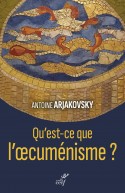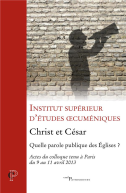
Catholiques et orthodoxes : Les enjeux de l'uniatisme
de Comité mixte catholique-orthodoxe en France
Collection Documents des Églises - Public spéc
480 pages - avril 2004
62,70€
Depuis dix ans, huit théologiens orthodoxes et huit théologiens catholiques mandatés officiellement par leurs Églises se sont réunis pour réfléchir ensemble sur la difficile question de l'uniatisme. L'existence même des Églises catholiques unies ou « uniates », nées du rattachement à Rome de différentes communautés orthodoxes invitées à garder leur « rite », et censées faire œuvre d'unité entre Orient et Occident chrétiens, a toujours suscité l'opposition des orthodoxes qui y voyaient des « unions » artificielles attentatoires à l'intégrité de leur Église. Ce problème ecclésiologique qui affecte de nouveau les relations entre catholiques et orthodoxes a été abordé, en juin 1993 à Balamand (Liban), par la Commission mixte internationale de dialogue théologique entre les deux Églises ; celle-ci a adopté une déclaration importante sur « L'uniatisme, méthode d'union du passé, et la recherche actuelle de la pleine communion ». C'est dans le sillage de Balamand que les théologiens du Comité mixte de dialogue catholique-orthodoxe en France, auxquels s'étaient joints quelques spécialistes, ont tenté d'examiner tous ensemble les origines de l'uniatisme et de relire les pages de l'histoire de ce phénomène complexe, en mettant en évidence sa genèse, son développement diversifié et sa théorisation tardive. Ils ont souhaité éclairer le Document de Balamand, en montrer les points forts autant que les limites, pour comprendre le grand espoir que ce message peut susciter en donnant un nouvel élan au dialogue entre les deux Églises.
--
For the past ten years, eight Orthodox and eight Catholic theologians, officially mandated by their churches, have come together to ponder the difficult question of uniatism. The very existence of united or ‘uniate’ Catholic churches has always provoked opposition from the Orthodox Church who see in this phenomenon artificial ‘unions’ that are detrimental to the integrity of their Church. Born out of different orthodox communities joining with Rome – although encouraged to retain their own rite - those communities are intended to operate as a bonding element between Eastern and Western Christians. This ecclesiological problem, which impinges once more upon the relations between Catholics and the Orthodox Church, was tackled at Balamand (Lebanon) in June 1993, by the mixed international Commission for theological dialogue between the two Churches. The Commission issued an important statement on ‘Uniatism, an outdated means of achieving unity, and the current search for full communion’. It is in the wake of Balamand that the theologians of the Comité mixte de dialogue catholique-orthodoxe in France, joined by a few specialists, have tried to examine the origins of uniatism and look again at the history of this complex phenomenon, giving prominence to its genesis, its diversified evolution and its tardy theorization. Their aim is to clarify the Balamand Document, underlining its strengths as well as its limitations, in order to understand the great hope this message can inspire by giving a fresh boost to the dialogue between the two Churches.
--
For the past ten years, eight Orthodox and eight Catholic theologians, officially mandated by their churches, have come together to ponder the difficult question of uniatism. The very existence of united or ‘uniate’ Catholic churches has always provoked opposition from the Orthodox Church who see in this phenomenon artificial ‘unions’ that are detrimental to the integrity of their Church. Born out of different orthodox communities joining with Rome – although encouraged to retain their own rite - those communities are intended to operate as a bonding element between Eastern and Western Christians. This ecclesiological problem, which impinges once more upon the relations between Catholics and the Orthodox Church, was tackled at Balamand (Lebanon) in June 1993, by the mixed international Commission for theological dialogue between the two Churches. The Commission issued an important statement on ‘Uniatism, an outdated means of achieving unity, and the current search for full communion’. It is in the wake of Balamand that the theologians of the Comité mixte de dialogue catholique-orthodoxe in France, joined by a few specialists, have tried to examine the origins of uniatism and look again at the history of this complex phenomenon, giving prominence to its genesis, its diversified evolution and its tardy theorization. Their aim is to clarify the Balamand Document, underlining its strengths as well as its limitations, in order to understand the great hope this message can inspire by giving a fresh boost to the dialogue between the two Churches.
- Dimensions : 150x220x30
- ISBN : 9782204073332
- Poids : 672 grammes






